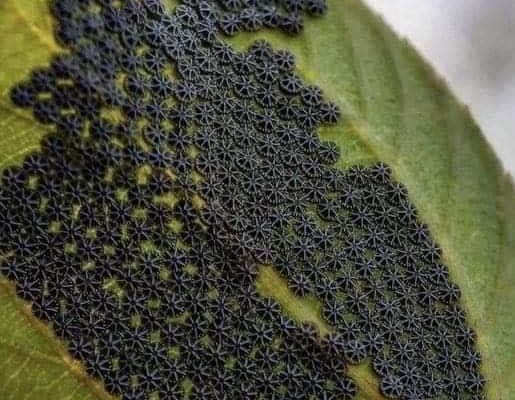You know where I spend most of my time? In my garden. I really enjoy gardening. It feels great to take care of plants, watch them grow, and see the results of my hard work. But let’s admit it—it can be quite challenging. Dealing with pests is one of the toughest parts. Sometimes, it’s hard to tell which pests are helpful and which ones will ruin all your efforts.
Recently, I saw a picture on social media that showed this confusion perfectly. It scared me at first. The picture showed a leaf covered in small, detailed, black shapes. At first, it looked like the leaf had some strange alien pattern or maybe a disease. Many people, including me, were curious about what it could be.

After doing some research, I found out that these weird patterns are actually eggs of the Nymphalis Antiopa butterfly. Now, if you don’t know about this butterfly, let me tell you about it. The Nymphalis Antiopa, also called the Mourning Cloak butterfly, is a fascinating insect with a unique life cycle and some interesting habits.
Now, let’s talk about the eggs. The picture I saw was a close-up of these eggs on a leaf. They look like delicate black lace spread across the leaf. It’s actually quite beautiful once you get over the surprise. The eggs are laid in groups, and each small egg is a perfect little geometric marvel. When I first saw them, I thought, “This could either be really good or really bad for my garden.”
The good news is that the Nymphalis Antiopa butterfly is helpful. The young ones, called caterpillars, eat leaves, but they usually like trees and shrubs such as willows, elms, and poplars. So, if your garden has lots of flowers and veggies, you’re likely okay. Actually, these butterflies can be quite useful because they also eat decaying fruit and assist in breaking it down.

Watching the life cycle of these butterflies is really interesting. After coming out of those strange, detailed eggs, the caterpillars appear. They’re black with small white spots and have spiky, hairy bodies. They go through many stages, called instars, where they shed their skin and grow bigger each time.
When they’re fully grown, the caterpillars find a safe spot to change. They make a chrysalis, like a little sleeping bag, where they transform. This part can take a few weeks to several months, depending on the weather and time of year. When they finally come out, they’re beautiful Mourning Cloak butterflies with dark, velvety wings edged in bright yellow and decorated with blue spots.
One cool thing about Mourning Cloak butterflies is how they behave. Unlike many others, they sleep during the winter. They find a warm place under loose bark, in a pile of wood, or even in an old shed. When spring comes, they’re among the first butterflies you see, often before the flowers bloom. This early appearance is why they’re called Mourning Cloaks—the dark wings against the early spring landscape look a bit like mourning clothes.

As gardeners, we often worry about insects immediately harming our plants. We see caterpillars and think, “Oh no, they’ll eat everything!” But it’s important to step back and look at the whole picture. The Nymphalis Antiopa butterfly is a great example of how nature finds balance. Yes, the caterpillars will eat some leaves, but they won’t destroy your garden. Actually, by giving these butterflies a place to live, you’re helping the environment.
So, what should you do if you find these eggs or caterpillars in your garden? My suggestion is to let them be. Enjoy watching them grow and change. If you’re really worried about your plants, you can gently move the caterpillars to a tree or shrub where they’ll be happier and less likely to eat your flowers.

Gardening is about finding a balance. It’s about making peace between the plants you like and the animals that live with you. When you spot something odd in your garden, take a minute to check it out before using bug spray. You might find something cool, like I did with the Nymphalis Antiopa butterfly eggs.
In the end, it’s all part of the fun. Every season brings new things to discover and deal with, but that’s what makes gardening so satisfying.



